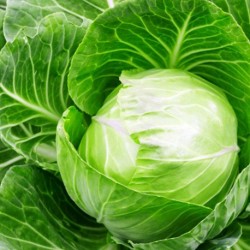



Earliest of All Cabbage as the name suggest is a very early variety. Ready to pick in about 2 months after germination. Small, round crispy heads. If you want a longer supply of cabbages throughout the growing season grow this variety first and the second earliest Golden Acre cabbage too.
Sowing
Plants are best started about 5-7 weeks before planting out. Cabbage sprouts are a bit delicate to transplant so unless you have experience it is best to start them in cell trays or small pots. Two or three seeds per cell should be placed on pre moistened soil and covered with approximately 1/8” of potting mix. Water in well. Do not place on heat mat as cabbages do not like heat and this will lead to problems with molds and heat-related rots.
Care of Seedlings
Once seedlings sprout and are starting to produce their first true leaves, thin to one plant per cell. Let seedlings dry slightly between watering. Be careful not to over water. Avoid chlorinated tap water, water can be filtered or left out overnight to allow the chlorine to dissipate
Transplanting
Depending on the size of cell tray you used, your seedlings may show signs of stunting or nutrient deficiency. If this happens consider using a larger size of cell pack next year and you can carefully pop them out of their cells and pot them into a two or three inch pots. Use a mix with a bit of compost added and water well once transplanted
Continuing Care
Your baby cabbages will be happiest if you let them dry slightly between watering. Like any transplant, it is a good idea to increase the strength of your fertilizer as the plants grow and you get closer to planting them out as they will use up most of the nutrients in their pots. Also, the lower leaves may yellow, this is perfectly fine and they can be easily removed with a pair of clean scissors or shears. This will prevent any issues with rot from occurring. It can also be really helpful for your transplants to have a desk fan blowing on them to strengthen them and prevent mold from crowding or water from sitting on the leaves for too long.
Hardening Off
Cabbages are a cool season crop and you should aim to harvest them before the summer gets too hot as they may bolt. Once the weather and soil have warmed sufficiently (which varies based on your growing zone) it is time to prep your baby cabbages to be planted outside. This process is known as hardening off and is meant to slowly adjust your plants to the sun, wind, humidity and temperature outside. The basics of this is to put your plants in a sheltered location outside for a couple hours at first and slowly increase the time and exposure they receive. First, be sure your daytime temperatures are above 10 degrees Celsius. Once acclimated, cabbages can endure almost freezing temperatures. Start with partial shade and shelter from all wind for tomatoes and then slowly expose them to full sun and air movement. This whole process should take about 5-8 days depending on how drastic of a change you are making.
Planting Out
Be sure that the site you are planting is well prepped. Dig the soil well to loosen and aerate it, add compost and other amendments at this point. Cabbages tend to have weak root systems so bone meal can really help with root growth. Wood ash or horticultural lime is also a good amendment for cabbages as it helps to prevent infestations of nematodes, stem borers and soil grubs. It can also be helpful to water the hole before planting if the ground is dry. Plant transplants slightly below soil level. This will help the plants grow a large, healthy, deep root system and ensure that the root zone stays moist at first. It is best to plant cabbages in a double row so that they shelter each other and you can make the most of the row cover if it is necessary. They should be spaced 12” between each plant and 10” between rows in a zig-zag arrangement. Mulch well.
NOTE: A row cover is used to prevent cabbage moths from laying their eggs on your plants. Be sure to weight them down well so that the wind doesn’t blow it away (bricks work great). Alternatively, if you are in an area that has cabbage moths and you do not wish to cover them, you can buy insecticidal dust for your plants at pretty much any garden center.